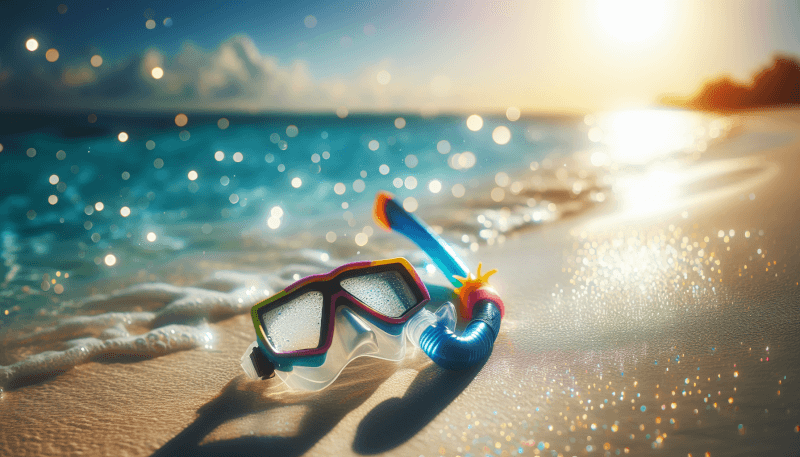Heading to the beautiful beaches of Florida for a snorkeling adventure? Before you dive into the crystal-clear waters filled with vibrant marine life, it’s important to ensure your safety. This article provides essential snorkeling safety tips specifically tailored for the stunning snorkeling spots in Florida. From checking the weather conditions to wearing the right gear, we’ve got you covered so you can enjoy a memorable and worry-free experience exploring the underwater wonders of the Sunshine State.

Choosing the Right Snorkeling Location
Snorkeling can be an incredibly rewarding and enjoyable activity, but it’s important to choose the right location to ensure a safe and memorable experience. Before heading out to explore the underwater wonders, research the local conditions of the snorkeling spot you have in mind. Look for information on water visibility, current strength, and any potential hazards. This will help you make an informed decision and avoid any unpleasant surprises.
When it comes to snorkeling, calm waters are your best friend. Look for areas with little to no waves and minimal current. Snorkeling in calm waters not only provides better visibility but also allows you to conserve energy and focus on enjoying the marine life around you. Steer clear of locations known for strong currents or rough waters as they can make your snorkeling experience challenging and potentially dangerous.
While popular snorkeling spots may seem enticing, it’s often best to avoid high-traffic areas if safety is your priority. These spots tend to attract a large number of snorkelers, boats, and other water vessels, increasing the risk of accidents. Instead, opt for quieter and less crowded locations where you can have a more peaceful experience with fewer distractions and potential hazards.
Checking the Weather
The weather plays a crucial role in snorkeling safety. Before heading out, it’s essential to monitor weather forecasts. Keep an eye on any potential changes in wind speed, storms, or other adverse weather conditions. Snorkeling in strong winds can make it difficult to swim and control your movements in the water. Additionally, snorkeling during storms is extremely dangerous, as it puts you at risk of being struck by lightning or being caught in strong currents.
Always prioritize your safety and never underestimate the power of Mother Nature. If the weather conditions are not ideal for snorkeling, it’s best to postpone your underwater adventure and wait for better conditions. Remember, there will always be another opportunity to explore the underwater world, but your safety should never be compromised.

Learning to Swim
Being able to swim confidently is a prerequisite for snorkeling. If you’re not a strong swimmer, it’s highly recommended to take swimming lessons before venturing into the water with a snorkel. Swimming lessons will not only improve your technique and endurance but also increase your confidence in the water.
Once you have the basics down, it’s important to practice swimming in open water before snorkeling. Open water presents unique challenges such as waves, currents, and potentially limited visibility. Familiarizing yourself with these conditions will help you become more comfortable and better prepared for snorkeling adventures.
In addition to swimming skills, it’s essential to improve your overall fitness and stamina. Snorkeling can be physically demanding, especially in areas with currents. Engaging in regular cardiovascular and strength training exercises will enhance your endurance, allowing you to enjoy longer and more rewarding snorkeling sessions.
Using Snorkeling Equipment
Investing in high-quality snorkeling gear is crucial for a safe and enjoyable experience underwater. Quality equipment not only ensures reliability but also enhances your snorkeling experience. Look for reputable brands that prioritize safety and durability when purchasing your snorkeling gear.
Proper fit is essential when it comes to snorkeling masks and snorkels. Ill-fitting equipment can cause discomfort, leakage, and even restrict your vision or breathing. Before purchasing or renting any gear, make sure to try it on and ensure a snug and comfortable fit. A properly fitted mask should create a seal around your face, while the snorkel should allow effortless breathing without strain.
Before each snorkeling session, it’s important to thoroughly check your equipment for any damage or wear. Inspect your mask for any cracks or scratches that may affect visibility. Check the snorkel for any blockages and ensure the mouthpiece is secure. Taking a few minutes to inspect your gear can prevent any potential issues during your snorkeling adventure.

Buddy System and Safety Precautions
Snorkeling is always more fun and safer when done with a buddy. Having a diving buddy ensures that someone is there to assist you in case of an emergency or to simply share in the excitement of discovering incredible marine life. Snorkeling alone is discouraged as it increases the risks associated with accidents, such as getting tangled in seaweed, encountering marine life injuries, or any other unforeseen circumstances.
Regardless of whether you are snorkeling alone or with a group, it’s important to maintain a safe distance from boats and other snorkelers. Avoid getting too close to boats or snorkeling in busy boat traffic areas, as they pose a significant risk of collision. Additionally, keep an eye out for other snorkelers around you and respect their space to avoid accidental collisions.
Knowing your limits and staying within your comfort zone is essential for safe snorkeling. Do not push yourself beyond your capabilities or attempt to go deeper or farther than you feel comfortable with. Snorkeling should be a relaxing and enjoyable experience, so take your time, explore at your own pace, and always listen to your body.
Understanding Marine Life and Environment
Before venturing into the underwater world, take the time to research the marine life you may encounter and their behaviors. Understanding the habits and tendencies of different marine species will not only allow you to appreciate their natural beauty but also help you avoid any potentially harmful encounters. Some marine creatures may be territorial or have defensive mechanisms, so knowing how to interact respectfully and responsibly is essential.
One of the cardinal rules of snorkeling is to never touch or disturb marine life. While it may be tempting to reach out and touch a vibrant coral or exotic fish, such actions can cause irreversible damage to delicate ecosystems. Treat the underwater environment with respect and always observe marine life from a safe distance. Remember, you are a visitor in their world, and it’s important to leave it as you found it.
While most marine life is harmless, there are a few species that you should be cautious of. Familiarize yourself with potentially hazardous marine life in the area you plan to snorkel. Species such as jellyfish, sea urchins, or certain venomous fish may pose a threat. Knowing what to look out for will allow you to snorkel safely and minimize the risk of encountering any dangerous situations.

Practicing Proper Snorkeling Techniques
Learning and practicing proper snorkeling techniques can greatly enhance your underwater experience. Mastering proper breathing techniques is crucial for efficient and comfortable snorkeling. Breathe through your mouth using slow and controlled breaths, allowing yourself to relax and adjust to the water pressure. Avoid breathing rapidly or holding your breath for extended periods, as it can cause discomfort or strain.
Equalizing your ears is another essential skill to learn. As you descend underwater, the pressure on your ears increases. To equalize the pressure, pinch your nose and gently blow air through your nostrils. This will help prevent discomfort and potential ear injuries. Practice equalizing your ears on land before your snorkeling adventure to become familiar with this technique.
Maintaining good buoyancy control is key to effortless snorkeling. By finding the right balance, you can conserve energy and float effortlessly on the water’s surface. Practice controlling your buoyancy by adjusting your body position and using your fins to propel yourself forward or to change direction smoothly.
Sun Protection
Snorkeling often involves spending extended periods under the sun, which makes sun protection essential. Apply sunscreen liberally before entering the water, focusing on exposed areas such as your face, neck, arms, and legs. Choose a sunscreen with a high SPF and broad-spectrum protection to shield your skin from harmful UV rays.
In addition to sunscreen, wearing protective clothing and gear can provide an extra layer of sun protection. Consider wearing a rash guard or wetsuit to cover your body and minimize sun exposure. A brimmed hat and sunglasses with UV protection are also recommended to shield your face and eyes from direct sunlight.
Remember to stay hydrated while snorkeling. Spending time in the sun and water can lead to dehydration, so bring along a water bottle and drink regularly. Proper hydration will not only keep you comfortable but also help you maintain your energy levels throughout your snorkeling adventure.

Knowing the Signs of Hypothermia and Heat Exhaustion
Understanding the signs and symptoms of hypothermia is crucial when snorkeling in colder waters. Hypothermia occurs when the body loses heat faster than it can generate, resulting in a dangerously low body temperature. Symptoms include shivering, confusion, fatigue, and loss of coordination. If you or your snorkeling buddy experience any of these symptoms, it’s important to exit the water immediately and seek warmth and medical attention.
On the flip side, snorkeling in warm climates can put you at risk of heat exhaustion. Heat exhaustion occurs when your body overheats due to high temperatures and excessive physical exertion. Symptoms include dizziness, nausea, headache, muscle cramps, and excessive sweating. If you or someone you are snorkeling with displays signs of heat exhaustion, it’s crucial to move to a shaded area, hydrate, and cool down to prevent further complications.
Emergency Protocols and First-Aid
While snorkeling is generally a safe activity, it’s essential to be prepared for potential emergencies. Before embarking on your snorkeling adventure, make a note of the emergency contact numbers in the area you plan to snorkel. Familiarize yourself with the proper procedures to follow in case of an emergency, including how to report incidents and seek medical assistance.
Carrying a basic first-aid kit is highly recommended when snorkeling. Include essentials such as adhesive bandages, antiseptic wipes, tweezers for removing splinters or stingers, and any necessary medications you may require. Remember to periodically check your first-aid kit to ensure it is well-stocked and up to date.
Being mentally prepared for emergencies can help you respond calmly and quickly if the need arises. Stay aware of your surroundings, and if you encounter an emergency situation, assess the risks and take appropriate action to ensure your safety and the safety of others involved. Remember, always prioritize personal safety above all else.
By following these snorkeling safety tips, you can enjoy a fun and unforgettable underwater adventure while staying safe. Remember to plan ahead, make informed decisions, and always prioritize your well-being and that of your snorkeling buddies. Snorkeling is a fantastic way to explore the beauty of the ocean, and with the right precautions, you can create cherished memories that will last a lifetime.


